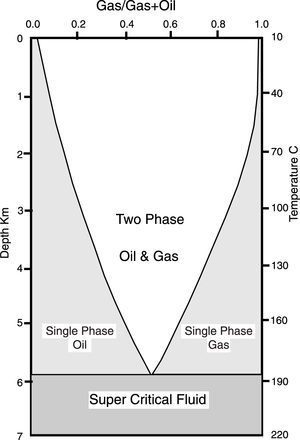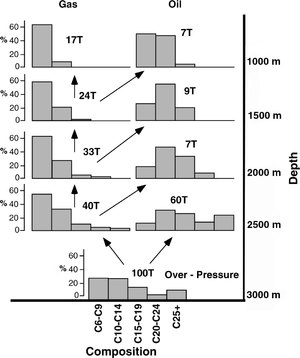Migration by separate phase
| Exploring for Oil and Gas Traps | |

| |
| Series | Treatise in Petroleum Geology |
|---|---|
| Part | Critical elements of the petroleum system |
| Chapter | Migration of petroleum |
| Author | Martin D. Matthews |
| Link | Web page |
| Store | AAPG Store |
Continuous, separate-phase migration of hydrocarbons moves high volumes of hydrocarbons during primary, secondary, tertiary, and remigration. Several processes can occur during separate-phase migration: formation of small free hydrocarbon masses, slug flow, cosolution, and compositional changes due to phase changes.
Small free hydrocarbon masses
The existence of small free hydrocarbon masses in the subsurface is inevitable. Each kerogen particle produces such a mass. Small hydrocarbon masses are commonly subdivided by size:
- Colloids—masses the size of median shale pores
- Emulsions—masses the size of large shale pores
- Droplets—masses larger than most shale pores
Of these, only hydrocarbon colloids are able to travel through the largest pore throat network without the limiting effects of capillarity. There is doubt, however, that a small mass of hydrocarbons has sufficient buoyant force to free itself from its attraction to the surface of a kerogen particle.
Slug flow in primary migration
Slug flow (or bulk phase flow) is generally accepted as the dominant mechanism of primary hydrocarbon migration. Within the source rock, the volume of hydrocarbons produced from kerogen increases until a continuous mass forms (a slug) that has enough force to overcome the capillary forces of the largest pore throat network. At that time, the slug moves into the closest coarse-grained bed. Expulsion is preferentially upward because of the hydrocarbons' buoyancy, but it may be downward due to generation and compaction pressure if the pathway is less restrictive. Expulsion probably acts discontinuously, resulting in periodic slugs of migrating hydrocarbons. Broad compositional differences between the slug and those hydrocarbons generated from the kerogen appear to be due to preferential retention of large hydrocarbons by fine pores.

Slug flow in secondary, tertiary, and remigration
Slug flow also dominates secondary, tertiary, and remigration. At each contact between a coarse pore network and a fine pore network, the mass of hydrocarbons accumulates until it reaches a buoyancy pressure great enough to overcome the capillary forces of the fine pore network. Relative permeability effects also aid migration. As hydrocarbons fill a pore network, the ability of a pore network to transport water decreases. This process builds pore pressure, helping push the hydrocarbons through the capillary restrictions.
Slug flow compositional changes
Changes in hydrocarbon composition during secondary, tertiary, and remigration do not appear to be significant. Bulk phase flow minimizes the opportunity of the hydrocarbons to interact with the substrate. Bulk phase flow overloads the adsorption–desorption capability of the substrate due to the quantity and concentration of the migrating hydrocarbons. Broad compositional modifications may be related to physical filtering of the larger hydrocarbons during their passage through a fine pore throat network.
Cosolution
Hydrocarbons have the capability of dissolving other hydrocarbons in them. This process is called cosolution. Methane, for example, which might normally be in a gaseous form, can be dissolved in a liquid oil. Similarly, a small amount of normally liquid oil may be dissolved in gaseous methane and be transported as part of the gas. The properties of the carrying phase are altered by the dissolved component.
Pressure effects
At pressures that exceed the critical point for hydrocarbon mixtures, the terms “gas phase” and “oil phase” become ambiguous. A single phase generally occurs at pressures above 4,000 psi and temperatures above temperature::200°F (temperature::93°C). For a hydrostatic gradient, this pressure converts to a little less than depth::9,000 ft with a geothermal gradient of about temperature::1.5°F/100 ft and a surface temperature of temperature::70°C.
Phase effects on composition
A migrating hydrocarbon mass passes into different pressure and temperature conditions. As this happens, the mass may separate from its original phase into two phases, each containing a different mixture of hydrocarbons. In the phase diagram in Figure 1, the X-axis shows the phase of the migrating hydrocarbons. The Y-axis on the left side shows pressure in terms of depth. The Y-axis on the right side shows the temperature.
Compositional changes during phase changes

Phase migration occurs when a gas is expelled with oil or migrates through an oil-rich source rock. The figure below shows the gasoline range and heavier hydrocarbons in a single-phase fluid expelled from a source rock at 3000 m. As the fluid migrates upward to lower temperatures and pressures, it undergoes a process called separation migration. At 2500 m, the 100 tons of single phase have separated into 40 tons of gas and 60 tons of oil.
Figure 2 shows the composition of each phase and the mass partitioning of the migrating-gas phase as the liquids are trapped. Note that the migrating-gas phase becomes enriched in the gasoline range and the liquids left behind progressively lose their heavier compounds. Light gas compounds are not shown. Surface geochemical studies indicate the ratios at C1 to C5 are little changed by upward migration. Separation-migration can significantly alter the gross composition of the migrated and trapped intervals, while maintaining sufficient detailed similarities so they can be recognized as belonging to the same family and source rock.
Kerogen network
migration along a kerogen network can occur either one molecule at a time or as a separate phase. It is a special case, restricted to rich source rocks where a continuous kerogen network is likely.
See also
References
- ↑ Pepper, A. S., 1991, Estimating the petroleum expulsion behavior of source rocks: a novel quantitative approach, in W. A. England, and E. J. Fleet, eds., Petroleum Migration: Geological Society Special Publication no. 59, p. 9–31.
- ↑ Ungerer, P., F. Behar, P. Y. Chenet, B. Durand, E. Nogaret, A. Chiarelli, J. L. Oudin, and J. F. Perrin, 1984, Geological and Geochemical models in oil exploration, principles and practical examples, in G. Demaison and R .J. Murris, eds., Petroleum Geochemistry and Basin Evaluation: AAPG Memoir no. 35, p. 53–77.